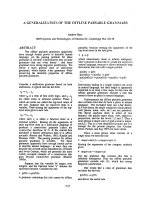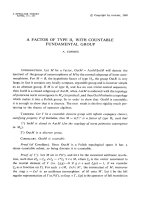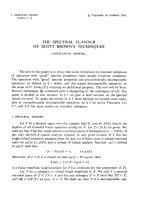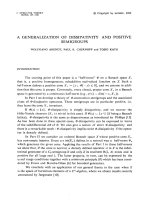Báo cáo toán học: "A Proof of the Two-path Conjecture" pps
Bạn đang xem bản rút gọn của tài liệu. Xem và tải ngay bản đầy đủ của tài liệu tại đây (52.76 KB, 3 trang )
A Proof of the Two-path Conjecture
Herbert Fleischner
Institute of Discrete Mathematics
Austrian Academy of Sciences
Sonnenfelsgasse 19
A-1010 Vienna
Austria, EU
herbert.fl
Robert R. Molina
Department of Mathematics and Computer Science
Alma College
614 W. Superior St.
Alma MI, 48801
Ken W. Smith
Department of Mathematics
Central Michigan University
Mt. Pleasant, MI 48859
Douglas B. West
Department of Mathematics
University of Illinois
1409 W. Green St.
Urbana, IL 61801-2975
AMS Subject Classification: 05C38
Submitted: January 24, 2002; Accepted: March 13, 2002
Abstract
Let G be a connected graph that is the edge-disjoint union of two paths of length
n,wheren ≥ 2. Using a result of Thomason on decompositions of 4-regular graphs
into pairs of Hamiltonian cycles, we prove that G hasathirdpathoflengthn.
the electronic journal of combinatorics 9 (2002), #N4 1
The “two-path conjecture” states that if a graph G is the edge-disjoint union of two
paths of length n with at least one common vertex, then the graph has a third subgraph
that is also a path of length n. For example, the complete graph K
4
is an edge-disjoint
union of two paths of length 3, each path meeting the other in four vertices. The cycle C
6
is the edge-disjoint union of two paths of length 3 with common endpoints. In the first
case, the graph has twelve paths of length 3; in the second there are six such paths.
The two-path conjecture arose in a problem on randomly decomposable graphs. An
H-decomposition of a graph G is a family of edge disjoint H–subgraphs of G whose union
is G.AnH-decomposable graph G is randomly H–decomposable if any edge disjoint
family of H–subgraphs of G can be extended to an H–decomposition of G. (This concept
was introduced by Ruiz in [7].)
Randomly P
n
-decomposable graphs were studied in [1, 5, 6, 4]. In attempting to
classify randomly P
n
-decomposable graphs, in [5] and [6] it was necessary to know whether
the edge-disjoint union of two copies of P
n
could have a unique P
n
-decomposition. The
two-path conjecture is stated as an unproved lemma in [3].
Our notation follows [2]. A path of length n is a trail with distinct vertices x
0
, ,x
n
,
([2], p. 5). We say that G decomposes into subgraphs X and Y when G is the edge-disjoint
union of X and Y .
Theorem. If G decomposes into two paths X and Y , each of length n with n ≥ 2, and
X and Y have least one common vertex, then G has a path of length n distinct from X
and Y .
Proof. Label the vertices of X as x
0
,x
1
, ,x
n
,withx
i−1
adjacent to x
i
for 1 ≤ i ≤ n.
Similarly, label the vertices of Y as y
0
,y
1
, ,y
n
.Lets be the number of common vertices;
thus G has 2n +2− s vertices.
If s = 1, then we may assume by symmetry that x
i
= y
j
with i ≥ j and i ≥ 1and
j<n. In this case, the vertices x
0
, ,x
i
,y
j+1
, y
n
form a path of length at least n
having a subpath of length n different from X and Y .
Similarly, if s = 2, then we may let the common vertices be x
i
1
,x
i
2
and y
i
1
,y
i
2
with
x
i
1
= y
j
1
and x
i
2
= y
j
2
. Using symmetry again, we may assume that i
1
<i
2
, j
1
<j
2
,and
i
1
≥ j
1
. With this labeling, again the vertices x
0
, ,x
i
1
,y
j
1
+1
, y
n
form a path with a
subpath of length n different from X and Y .
Hencewemayassumethats ≥ 3. The approach above no longer works, since now the
points of intersection need not occur in the same order on X and Y . Suppose first that
the intersection contains an endpoint of one of the paths. We may assume that x
0
= y
k
for some k with k<n. Now we consider two cases. If y
k+1
is not a vertex of X,then
we replace the edge x
n−1
x
n
with the edge y
k+1
x
0
to create a third path of length n.If
y
k+1
= x
i
for some i, then we replace the edge x
i
x
i−1
with the edge y
k+1
x
0
to create a
new path of length n.
Therefore, we may assume that s ≥ 3 and that none of {x
0
,x
n
,y
0
,y
n
} is among the s
shared vertices. We apply a result of Thomason ([8], Theorem 2.1, pages 263-4): If H is
a regular multigraph of degree 4 with at least 3 vertices, then for any two edges e and f
the electronic journal of combinatorics 9 (2002), #N4 2
there are an even number of decompositions of H into two Hamiltonian cycles C
1
and C
2
with e in C
1
and f in C
2
.
From the given graph G, we construct a 4-regular multigraph H. We first add the
edges e
0
= x
0
x
n
and f
0
= y
0
y
n
. We then “smooth out” all vertices of degree 2; that is, we
iteratively contract edges incident to vertices of degree 2 until no such vertices remain.
Since every vertex of G ∪{e
0
,f
0
} has degree 2 or degree 4, the resulting multigraph H is
regular of degree 4. Since s ≥ 3, H has at least three vertices.
In H,theedgee
0
is absorbed into an edge e,andf
0
is absorbed into an edge f.The
cycles X ∪{e
0
} and Y ∪{f
0
} have been contracted to become Hamiltonian cycles in H.
Together they decompose H. By the theorem of Thomason, there is another Hamiltonian
decomposition C
1
,C
2
of H with e in C
1
and f in C
2
.
Now we reverse our steps. Restore the vertices of degree 2 and remove the edges e
0
and f
0
. The cycle C
1
becomes a path from x
0
to x
n
,andC
2
becomes a path from y
0
to y
n
. Neither of these paths is the original X or Y .SinceG has 2n edges and is the
edge-disjoint union of these two paths, one of the paths has length at least n.Itcontains
a new path of length n.
References
[1] L.W. Beineke, W. Goddard, and P. Hamburger, Random packings of graphs, Discrete
Mathematics 125 (1994) 45–54.
[2] B. Bollob´as, Modern Graph Theory, Springer-Verlag (1998).
[3] P. Carolin, R. Chaffer, J. Kabell, and K.W. Smith, On packed randomly decompos-
able graphs, preprint, 1990.
[4] J. Kabell and K.W Smith, On randomly decomposable graphs, preprint, 1989.
[5] M. McNally, R. Molina, and K.W. Smith, P
k
decomposable graphs, a census,
preprint, 2002.
[6] R. Molina, On randomly P
k
decomposable graphs, preprint, 2001.
[7] S. Ruiz, Randomly decomposable graphs, Discrete Mathematics 57 (1985), 123–128.
[8] A. G. Thomason, Hamiltonian cycles and uniquely edge colourable graphs, Annals
of Discrete Mathematics 3 (1978), 259–268.
the electronic journal of combinatorics 9 (2002), #N4 3

![Báo cáo khoa học: A dimer of the FeS cluster biosynthesis protein IscA from cyanobacteria binds a [2Fe2S] cluster between two protomers and transfers it to [2Fe2S] and [4Fe4S] apo proteins ppt](https://media.store123doc.com/images/document/14/rc/tl/medium_tlm1396203606.jpg)







